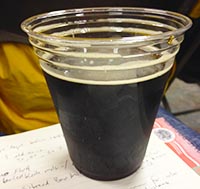 One of a wine’s primary flavor elements is acidity. Wines that are high in acid will taste sharp or sour, while wines low in acid will taste lifeless or flabby. Without a doubt, having the proper amount of acid is crucial to the flavor of your wine.
One of a wine’s primary flavor elements is acidity. Wines that are high in acid will taste sharp or sour, while wines low in acid will taste lifeless or flabby. Without a doubt, having the proper amount of acid is crucial to the flavor of your wine.
In many fruit wine recipes, the amount of acid or acid blend that should be added to the wine must is listed right along with the other wine making ingredients. By adding the acid blend called for, you are bringing the acid level of the wine up to a normal flavor range.
The reason you are able to get your wine into a proper range using these wine recipes with no issue is primarily because they are made up of a significant amount of water. This makes the amount of acid blend needed very predictable since a only a fraction of the total acidity is coming from the fruit itself.
But there are situations where acidity is not so predicable and acid readings need to be taken to know how much acid blend, if any, needs to be added. Such is usually the case when making wine from actual wine grapes, where the wine is made up of 100% grape juice with no water. If the acidity of the grapes are unusually high or low in a particular year, the flavor of the resulting wine will be negatively affected. In this scenario, taking an acid reading with an acid testing kit can be just as critical as taking a sugar level reading with a wine hydrometer.
Acid readings are normally taken right before fermentation, or right after the grapes have been ran through the grape crusher. Adjustments may be made at this time based on the reading given.
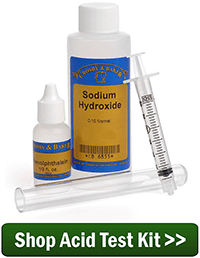 Taking readings with an acid testing kit is very straight-forward. Essentially, what you are doing is preforming a titration. A drop or two of activator is added to a measured sample of the wine. Then measured amounts of a reagent are added to the wine until you detect a permanent color change in the wine sample. By knowing how much reagent it took to change the wine’s color, you can accurately calculate the wine’s acid level. You can read more about this in the blog post Use an Acid Test Kit.
Taking readings with an acid testing kit is very straight-forward. Essentially, what you are doing is preforming a titration. A drop or two of activator is added to a measured sample of the wine. Then measured amounts of a reagent are added to the wine until you detect a permanent color change in the wine sample. By knowing how much reagent it took to change the wine’s color, you can accurately calculate the wine’s acid level. You can read more about this in the blog post Use an Acid Test Kit.
If the acidity is too low you add acid blend; if the acidity is too high you can dilute with water. We also have wine making products such as acid reducing crystals that are designed to reduce the acidity of the wine. The acid reducing crystals come with directions that will tell you how much to add to reduce the acidity by a specific amount.
—————
Ed Kraus is a 3rd generation home brewer/winemaker and has been an owner of E. C. Kraus since 1999. He has been helping individuals make better wine and beer for over 25 years.
Homebrew Beer Recipe: Honey Basil Saison
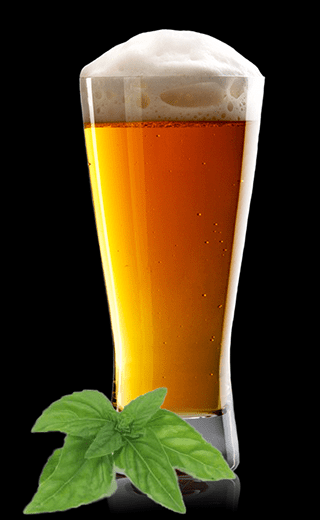 This is a honey basil saison beer recipe I put together for a friend’s wedding last summer. He was such a fan of my oregano pale ale that I figured he’d be interested in another beer in the same vein. This homebrew is a citrusy, spicy, bright orange beer that should be perfect for the outdoor festivities!
This is a honey basil saison beer recipe I put together for a friend’s wedding last summer. He was such a fan of my oregano pale ale that I figured he’d be interested in another beer in the same vein. This homebrew is a citrusy, spicy, bright orange beer that should be perfect for the outdoor festivities!
This homebrew recipe is something of an American spin on a Belgian farmhouse ale. It uses pale six-row malt as the base, some light Munich malt for some bready, toasty flavors, and a pound of caramel 40L for color and a touch of sweetness. One pound of honey contributes some additional fermentable sugars. The honey is added at the end of the boil to preserve some of its aromatic qualities. I’d recommend finding some raw honey from your local farmers market.
The fresh basil in this beer recipe is added towards the end of the boil. It will contribute a little bitterness, but mostly a distinctive spiciness in the nose, which blends well with the aromatics from the French saison yeast. I used regular Italian basil, but any variety of basil will work.
I brewed this batch of beer with the Brew in a Bag method. Feel free to adapt the beer recipe for your all-grain brewing setup, or replace the six-row and Munich malts with 6 lbs. of light liquid malt extract to make it a partial mash recipe.
Happy brewing!
Honey Basil Saison
(5-gallon batch – Brew in a Bag)
Specs
OG: 1.057
FG: 1.010
ABV: 6.2%
IBUs: 22
SRM: 10
Ingredients
6 lb. Pale 6-row malt
2.5 lb. Munich 10L
1 lb. Caramel 40L
.75 lb. White wheat malt
1 lb. Honey (added at flameout)
.5 oz. Northern Brewer hops at :60 (5 AAUs)
1 tsp. yeast nutrient at :15
.75 oz. fresh basil leaves at :5
.5 oz. Kent Goldings hops at :0 (3.6 AAUs)
.5 oz. Kent Goldings hops dry hopped for 3-5 days
1 packet Danstar Saison Yeast
Directions
Mash the crushed grains for 90 minutes at 148-150˚F. Strain out grains (some brewers like to rinse the grain bag). Bring wort to a boil and add hops and basil according to schedule above. At the end of the 60-minute boil, turn off the heat and mix in the honey. The final half-ounce of Kent Goldings hops can be adding during the whirlpool and chill. Cool wort to about 70˚F and transfer to a clean, sanitized fermenter. If needed, top off with enough pre-boiled, pre-chilled water to make 5 gallons. Pitch yeast and ferment at 70-75˚F for 7 days, then transfer to secondary for 10-14 days. Bottle or keg for 2.3-2.5 vols CO2.
—–
David Ackley is a beer writer, brewer, and self-described “craft beer crusader.” He holds a General Certificate in Brewing from the Institute of Brewing and Distilling and is founder and editor of the Local Beer Blog.
An Evening with Ron Pattinson and British “Mild” Beer
 OK – forget everything you think you know about British beer styles. Or beer styles in general for that matter. After an informative evening with beer historian Ron Pattinson, I discovered that style guidelines, as defined by groups like the BJCP, don’t always account for the sometimes drastic way beer has changed over the years.
OK – forget everything you think you know about British beer styles. Or beer styles in general for that matter. After an informative evening with beer historian Ron Pattinson, I discovered that style guidelines, as defined by groups like the BJCP, don’t always account for the sometimes drastic way beer has changed over the years.
Pattinson, who writes the beer blog Shut up About Barclay Perkins, gave a talk last week to my local homebrew club about mild beer. Specifically, how it has changed over the past 150 years. His remarks were illustrated by liquid examples – historical beer recipes re-created from archival brewing blogs.
As Pattinson explained, mild wasn’t always a term used to describe a specific style of beer, certainly not the low ABV, amber to dark ale as described by the BJCP. “Mild” used to simply refer to beers that were meant to be consumed fresh. These beers didn’t need copious amounts of hops to act as a preservative, so they were generally less hoppy than their “stock ale” counterparts.
Even the terms “beer” and “ale” held different meanings than they do today. Go back far enough, and “ale” simply referred to malt liquor flavored with herbs and spices, while “beer” referred to malt liquor brewed with hops. When looking back in time, the names we give to beer styles aren’t always very consistent.
To illustrate the point, the first beer we sampled that evening was closer to what we think of as an IPA than a mild. Just have a look at these specs:
- OG: 1.087
- FG: 1.025
- ABV: 8.2%
- IBUs: 120
- Ingredients: pale malt, Golding hops
This “mild” beer is brewed with almost a pound of hops per five gallons! I found it remarkably smooth for an 8.2% ABV, 120 IBU beer — likely a result of the 1.025 final gravity. It featured a spicy hop flavor, but the main difference between this beer and an IPA was the lack of hardly any hop aroma. Apparently very few British brewers from this time period added hops with less then 30 minutes to go in the boil. And according to Pattinson, this beer wasn’t even considered particularly strong at the time, when even the weakest mild had an original gravity of at least 1.070.
The next sample starts to show a trend towards lower gravities. Due to changes in the way beer was taxed and the legalization of brewing with sugars, we begin to see invert sugar as a common brewing ingredient. And due to the robust brewing economy in Great Britain, hops were at such a shortage that they had to import them from the US. Still, this recipe seems more like a conventional pale ale than a mild:
1890 Whitbread X
- OG: 1.060
- FG: 1.016
- ABV: 5.8%
- IBUs: 58
- Ingredients: pale malt, invert sugar #2, Cluster hops, Goldings hops, Spalt hops
In the early half of the 20th century things start taking a drastic turn. Two world wars make barley hard to come by. Gravities and alcohol contents continue to drop year over year and never return to their prewar levels. By this time, sugar is a common ingredient, particularly dark invert sugar syrups and caramel, which in addition to being inexpensive also contribute color and flavor to beer. Pattinson hypothesizes that as gravities declined, brewers made beers darker to essentially fool people into thinking they were stronger.
This mild from 1950 is entirely different from the first two beers we sampled, and much closer to what we consider a mild today. But still a very enjoyable session beer!
- OG: 1.031
- FG: 1.009
- ABV: 2.9%
- IBUs: 28
- Ingredients: pale malt, crystal malt, invert sugar #3, caramel (for color), Fuggles hops, Goldings hops
This lecture was very eye opening, and it challenged many previous notions about beer styles. Maybe we should spend less time categorizing beer and more time simply enjoying it!
Special thanks to Ron for visiting around brew club in Asheville! Be sure to check out his new book, the Home Brewer’s Guide to Vintage Beer, which contains many detailed recipes from over 150 years of brewing records.
—–
David Ackley is a writer, brewer, and craft beer marketing consultant. He holds a General Certificate in Brewing from the Institute of Brewing and Distilling and is founder of the Local Beer Blog.
8 Clone Beer Recipe Kits!
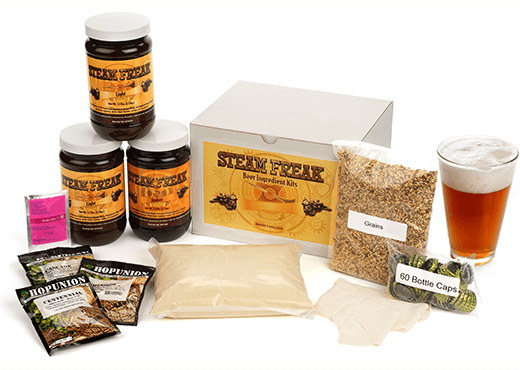 One of the best ways to improve your homebrewing abilities is to replicate commercial brews and compare them against the original. Did you get the color right? The flavor? How about the head retention? Can you detect any fermentation faults or off-flavors? There’s nothing quite like the feeling of when you nail the perfect clone beer recipe. Lets dive into the world of brewing clone beer with eight classic clone recipe kits:
One of the best ways to improve your homebrewing abilities is to replicate commercial brews and compare them against the original. Did you get the color right? The flavor? How about the head retention? Can you detect any fermentation faults or off-flavors? There’s nothing quite like the feeling of when you nail the perfect clone beer recipe. Lets dive into the world of brewing clone beer with eight classic clone recipe kits:
- Sahara Nevada Pale Ale (Sierra Nevada Pale Ale Clone)
Sierra Nevada Pale Ale is one of the original craft beers. When Ken Grossman launched Sierra Nevada back in 1980, little did he know that his Pale Ale would come to define the American pale ale. This clone beer recipe kit features just enough caramel malt and Carapils to give the beer enough a malty-sweet body to back up the generous dose of Cascade hops. 5.5% ABV, 44-48 IBUs.
- Blue Noon Belgian Wit (Blue Moon Clone)
Blue Moon represents what many would call their entry into drinking craft beer. Blue Noon is a refreshing Blue Moon clone recipe brewed with wheat, oats, and spices. It offers a full body combined with a complex citrus/wheat flavor that is worlds apart from other mass-market beers. Coriander and orange peel add a tart and spicy complexity. 5.4% ABV, 20-24 IBUs.
- S. S. Tadcaster Porter (Samuel Smith Taddy Porter Clone)
Samuel Smith’s Taddy Porter is a classic English Porter. Brewed with water from a 250+ year old well, Taddy Porter features roasted malt flavors with hints of dark fruit and molasses. This clone beer recipe kit uses classic English hop varieties to provide a moderate bitterness in balance to the malt. 4.6% ABV, 55 IBUs.
- Petey’s Evil Ale (Pete’s Wicked Ale Clone)
Pete’s Brewing Company was founded in 1986, and Pete’s Wicked was the brewery’s flagship beer, an American Brown Ale with nutty malt flavor and a fruity combination of English and American aroma hops. Though Pete’s was discontinued in 2011, Pete’s Wicked Ale will live forever as one of the original American craft beers. Resurrect Pete’s Wicked Ale with this easy clone beer recipe! 5.25% ABV, 40-44 IBUs.
- Fat Liar Amber Ale (Fat Tire Clone)
It’s hard to imagine the American craft beer movement without New Belgium’s Fat Tire. With its nutty and biscuity malt flavor, floral hop flavor, and exceptional balance, this Belgian-American amber ale is agreeable to a wide variety of palates. Have a friend that doesn’t like craft beer? A nice cold Fat Liar may bring them over to the other side. 5.8% ABV, 45 IBUs.
- Bazz Pale Ale (Bass Pale Ale Clone)
Bass is the English pale ale that defines the Burton-style English pale ale. It’s a fantastic session beer with an intriguing English hop aroma. An English yeast strain adds a subtle fruity aroma that’s characteristic of English Ales. 4% ABV, 33 IBUs.
- Buddy Light (Bud Light Clone)
Everyone needs a lawnmower beer! Though Bud Light may not be as complex as some other craft beers, you have to be impressed by its consistency – a Bud Light in LA tastes exactly like one in New York. Can you brew a clone that tastes just like what’s in the can? 3.3% ABV, 10 IBUs.
- Pilsner Urkel (Pilsner Urquell Clone)
Pilsner Urquell is the classic Czech pilsner. Bright gold in color, this clone of the iconic pilsner features the familiar flavor of Czech Saaz hops, which give this beer a relatively assertive hop bitterness. Ferment cool for best results. 5.25% ABV, 43 IBUs.
Do you have a favorite clone beer recipe? Which of these clone beer recipe kits would you like to try first?
3 Refreshing Wine Cooler Recipes that Will Get You Excited for Summer
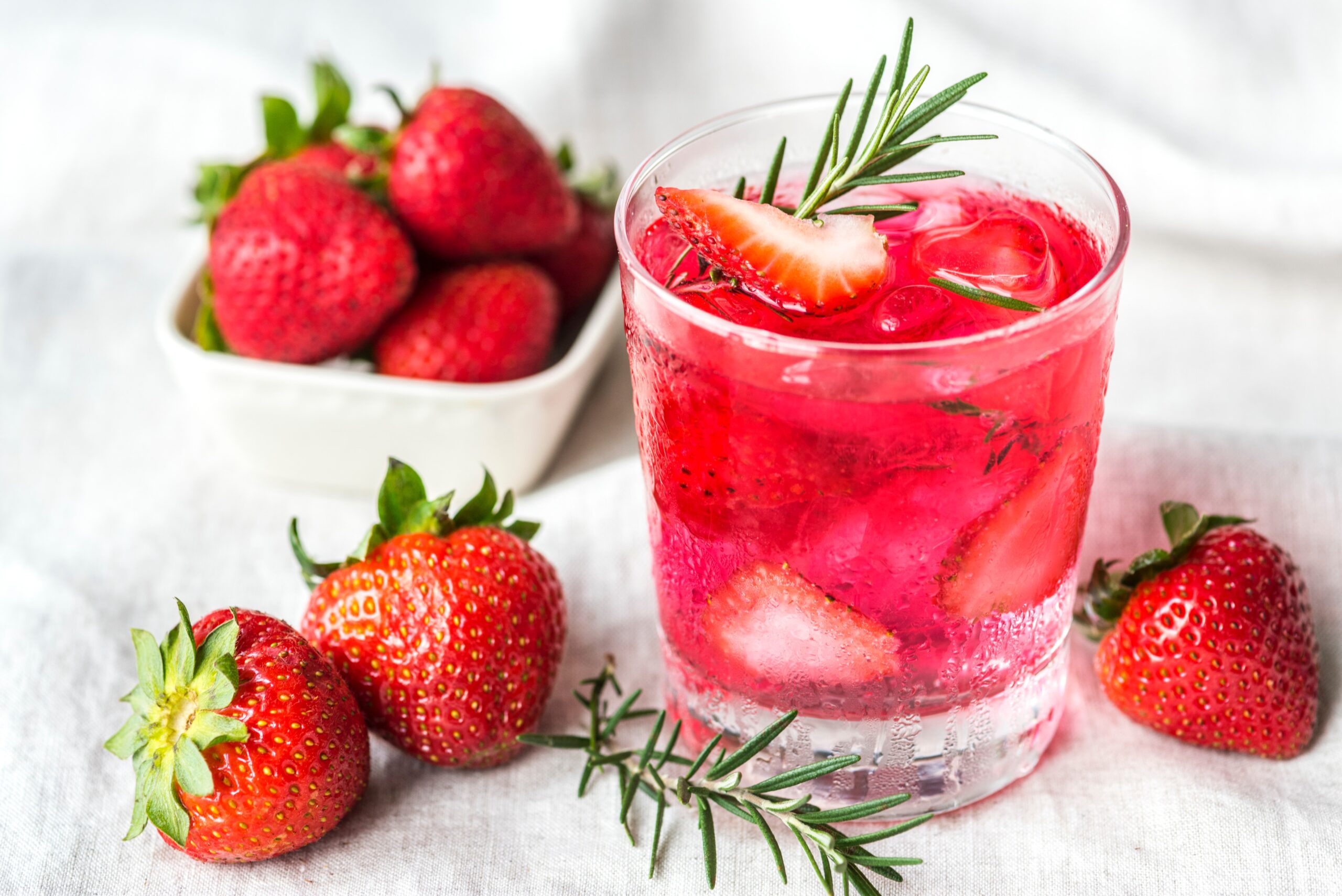 Summer is right around the corner and there is nothing sweeter, or more refreshing, than a nice homemade wine cooler during the scorching months of the year. Here is a recipe that is quick and tasteful for any wine lover. This recipe can also be interchangeable with any of our wine recipes to add more flavor to your cooler.
Summer is right around the corner and there is nothing sweeter, or more refreshing, than a nice homemade wine cooler during the scorching months of the year. Here is a recipe that is quick and tasteful for any wine lover. This recipe can also be interchangeable with any of our wine recipes to add more flavor to your cooler.
Whether its laying by the pool or enjoying a drink with some friends in the evening- here are three wine cooler recipes that will have your taste buds thanking you:
Tropical Pineapple Twist Cooler
Ingredients:
- 4 oz. of wine (Recommended: Our Pineapple Wine Recipe)
- 1 oz. pineapple or cranberry juice
- 2 oz. club soda
- Slice of lime
Directions:
Combine the wine, juice, and club soda. Fill a tall glass with ice and a lime wedge and then pour the contents of your drink and enjoy. The serving size is for a single glass but can be modified with a higher quantity of ingredients for a larger serving size.
This recipe is simple and takes little to no time unless you decide to chill the finished product for a few hours. Club soda will add a nice carbonated fizz to your cooler and our pineapple wine recipe will enhance the fruit flavor and give a more distinct taste. Other wine suggestions include a dry Riesling or pinot grigio. If you decide to use the pineapple wine recipe, cranberry juice can offset the pineapple but boost the citrus taste.
Strawberry Banana Refresher
Ingredients:
- 2 cups strawberries
- 750 ml. bottle of wine (Recommended- banana wine recipe or sauvignon blanc)
- 1/3 cup sugar
Directions:
Mix together the strawberries and sugar and let them sit for 10-15 minutes. In a blender, puree the strawberries until smooth and add the bottle of wine. Once the mixture is smooth and well blended pour contents into a large glass and serve chilled over ice. You can also add cut up strawberries or blueberries to enrich the flavor and the appearance. These ingredients make up to 4 servings.
Adding the banana wine recipe to this Strawberry Banana Refresher adds to the bare strawberry puree and combines the flavors to have you going back for more. Strawberry Banana is a classic combo and trying out this homemade recipe will have you feeling rejuvenated and confident to test out new recipes on your own.
Ginger Lime Cooler
Ingredients:
- 4 oz. wine (Recommend Ginger Root Wine or White Wine)
- 1-part lemon-lime soda
- 1-part Ginger ale
Directions:
Mix all three ingredients and let chill in refrigerator. Once mixture is cool, serve over ice and enjoy. Ingredients yield 1 serving.
This quick fixture is a take on the modern Moscow Mule (without the vodka, obviously). Our ginger root wine recipe adds tang to the creation and is balanced with the combination of ginger ale and sprite. This option is not as sweet as the Tropical Pineapple or Strawberry Banana, so it aids as a nice refreshing drink for those who enjoy a less fruity cocktail.
These fresh wine cooler recipes are great cocktails to serve when friends and family are over and will save you from the summer heat. If you are new to wine making or want to branch out from the recipes provided, check out our homemade wine options for a larger variety to include in your wine coolers.
Are there any wine cooler recipes that you recommend? Please share in the comments below!
The Essentials Of Adding Fruit To Beer
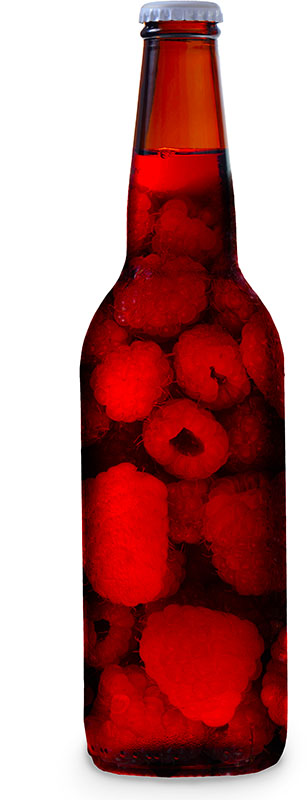 With the spring and summer seasons come the harvest of strawberries, peaches, blueberries, and more. Why not experiment a bit and make something a little different – your own seasonal brew? These warmer months are ideal for adding fruit to beer.
With the spring and summer seasons come the harvest of strawberries, peaches, blueberries, and more. Why not experiment a bit and make something a little different – your own seasonal brew? These warmer months are ideal for adding fruit to beer.
Before you start throwing apples and oranges in the brew kettle through, it’s a good idea to think about how much fruit to use and where to add it in the brewing process.
Here are some suggestions for adding fruit to beer:
First, try a few commercial fruit beers and think about how much fruit flavor you want in yours. Several craft beers on the market are made with fruit, with flavors intensities ranging from barely noticeable to a full-frontal assault. An example is 21st Amendment’s Hell or High Watermelon.
So do you want just a hint of fruit flavor, or something more dominating? Think about where you want to be on that range for your batch of fruit beer. Depending on the fruit in question, you may want to start with half a pound or so of fruit per gallon and work your way up from there.
Next, pick your beer recipe as your base style. Fruit beers work well with pale ales and wheat beers, but also dark beers in some cases. Raspberry works well in stouts, especially when combined with chocolate. Pick out a recipe kit that you think might fit with your fruit of choice, or develop your own recipe.
Peel, puree, or juice?
Next, think about how you want to add fruit to beer. In some cases, such as when brewing a Belgian Wit, a little citrus peel is enough to impact the flavor of the brew. Orange is the most common, but why not experiment with lemon, lime, or grapefruit? Adding peel will likely contribute more bitterness than fruit flavor.
In my experience, adding fruit to beer in secondary fermentation is an effective way to get fruit flavor into a beer. The exact method for preparing the fruit will vary depending on the fruit in question and whether it’s fresh or frozen fruit you are adding to the beer. Fresh fruit should be peeled, frozen, and thawed, while frozen fruit should just be thawed to avoid shocking the yeast in the fermenter.
You could also add fruit juice or puree to the secondary fermenter. I suggest using 100% juice without preservatives or artificial colors and flavorings. Start with a cup or so of fruit juice or puree in a 5 gallon batch for a subtle flavor, or more for something more intense.
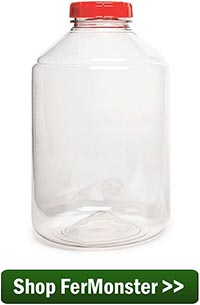 Whether you add whole fruit, pureed fruit, or fruit juice to your beer, keep in mind that some of the sugars in the fruit will ferment, raising the alcohol content of your homebrew and possibly adding fermentation time to the process.
Whether you add whole fruit, pureed fruit, or fruit juice to your beer, keep in mind that some of the sugars in the fruit will ferment, raising the alcohol content of your homebrew and possibly adding fermentation time to the process.
Fruit Extract
Another way of adding fruit to beer is to use fruit extract and add a few drops to each beer bottle on bottling day. You may want to take a sample of beer and play with ratios to figure out how many drops each bottle should get.
Fruit Liqueurs
Fruit liqueur can be used as both a flavoring and a priming agent. Instead of priming with corn sugar, the sugar found in liqueurs is enough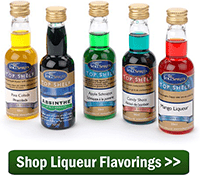 to carbonate your beer. Marty Nachel points out that “One 750ml bottle contains just about enough sugar to prime a 5-gallon batch of beer. Because the actual sugar contents of any liqueur depends on the company that made it (although it more likely has too little sugar than too much), you may want to add another ounce or two of dextrose to be sure.”
to carbonate your beer. Marty Nachel points out that “One 750ml bottle contains just about enough sugar to prime a 5-gallon batch of beer. Because the actual sugar contents of any liqueur depends on the company that made it (although it more likely has too little sugar than too much), you may want to add another ounce or two of dextrose to be sure.”
Have you every tried adding fruit to beer? How did it turn out? Share in the comments below!
Heady Topper Double IPA Clone Recipe
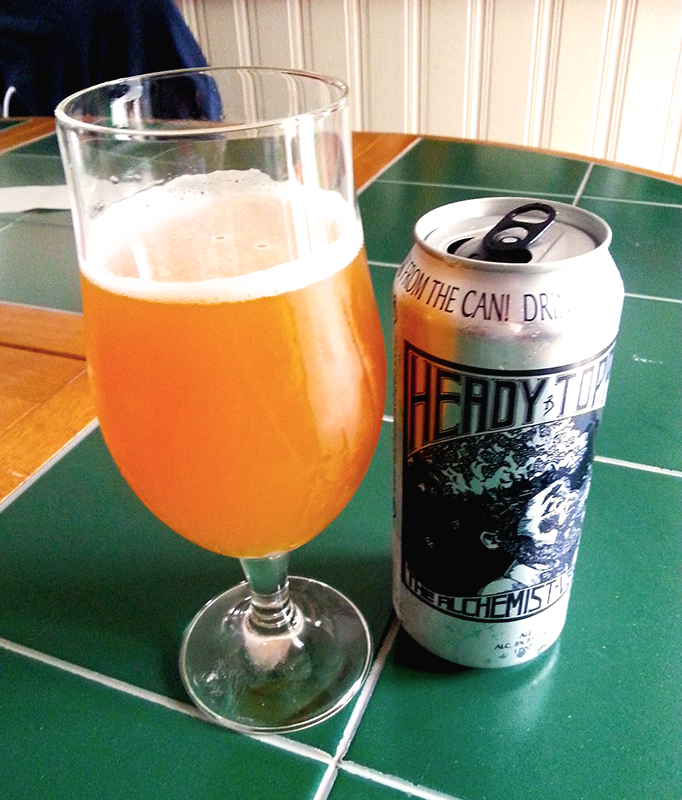 The Alchemist’s Heady Topper is one of the most coveted beers in America. Beer fans drive from all over the country for the chance to get “Heady” straight from the brewery in Waterbury, VT, and it’s not uncommon for people to line up for hours outside their favorite beer retailer in anticipation of a delivery of this ridiculously hoppy American Double IPA.
The Alchemist’s Heady Topper is one of the most coveted beers in America. Beer fans drive from all over the country for the chance to get “Heady” straight from the brewery in Waterbury, VT, and it’s not uncommon for people to line up for hours outside their favorite beer retailer in anticipation of a delivery of this ridiculously hoppy American Double IPA.
With any beer this popular, homebrewers naturally want to clone it. On the homebrewing website HomebrewTalk, there’s one thread with nearly 3000 comments from people trying to develop their own Heady Topper recipe!
Luckily, I have a friend who has brewed several batches to dial in his own Heady Topper double IPA clone recipe. When I visited him last winter, we did a side-by-side blind tasting and the two beers were nearly indistinguishable. With his permission, I’ve shared the recipe below. But first, some considerations.
Yeast
Many homebrewers believe that the single most important part of cloning this beer is to use the same yeast as the Alchemist uses in Heady Topper, but since it’s a proprietary strain, this is easier said than done. One option is to harvest yeast from a can of Heady (see How to Harvest Yeast from a Commercial Beer), but even obtaining a can of Heady can be a challenge. There are a few boutique yeast shops that offer cultured strains of the famous “Conan” yeast. The easiest option is to use a similar strain. I’ve included Wyeast’s London Ale 1028 as a substitute. Just be sure to build a yeast starter!
Hops
This beer uses a lot of hops! Most of them are added at the end of the boil during the whirlpool. If you read our recent post about hop oils, you know that many of the aromatic oils are driven off at higher temperatures. To preserve those oils, allow the wort to cool slightly before adding the whirlpool hops. If your brew kettle has a ball valve, you may want to invest in a torpedo screen to prevent all those hops from clogging it.
Ready to brew this Heady Topper Clone? Try this all-grain recipe, or use the partial mash option below. Happy brewing!
Sam’s Heady Topper Double IPA Clone Recipe
(5-gallon batch, all-grain)
Specs
OG: 1.078
FG: 1.017
ABV: 8%
IBUs: 120+
SRM: 6-7
Ingredients
MALT:
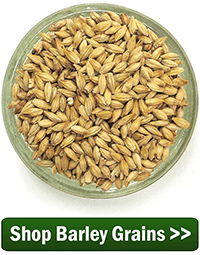 8 lbs. American two-row malt
8 lbs. American two-row malt - 5 lbs. German pilsner malt
- 1 lb. Carapils malt
- 1 lb. wheat malt
- .75 lb. honey malt
HOPS – This beer uses a lot of hops! You’ll need a total of:
- 4.75 oz. Summit hops,
- 3 oz. Centennial hops,
- 1 oz. Cascade hops,
- 1 oz. Citra hops,
- 1 oz. Amarillo hops)
2.5 oz. Summit at :60
.25 oz. Amarillo at :5
.25 oz. Cascade at :5
.25 oz. Centennial at :5
.25 oz. Summit at :5
1.5 oz. Centennial at :0
1 oz. Summit at :0
.5 oz. Citra at :0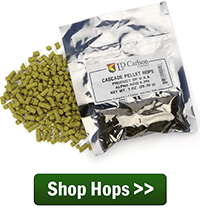
.25 oz. Cascade at :0
.25 oz. Amarillo at :0
.75 oz. Centennial, dry-hopped for 8 days
.5 oz. Citra, dry-hopped for 8 days
.5 oz. Summit, dry-hopped for 8 days
.5 oz. Amarillo, dry-hopped for 8 days
.5 oz. Centennial, dry-hopped for 4 days
.5 oz. Cascade, dry-hopped for 4 days
.5 oz. Summit, dry-hopped for 4 days
YEAST:
“Conan” yeast harvested from a can of Heady Topper or Wyeast 1028: London Ale – prepare a 2L starter
Directions
Mash crushed grains in about 6 gallons of clean, chlorine-free water at 150˚F for 60 minutes. Sparge to collect about 7 gallons of wort in the kettle, then bring wort to a boil. Add hops according to schedule above. For the 0 minute additions, add the hops gradually after cutting off the heat, allowing the hops to steep in the wort as you chill it down, at least 30 minutes, or for as long as an hour. When the wort temperature reaches 68˚F, transfer to a fermenter and pitch the yeast starter. Ferment for 7 days at 68˚F, then pitch first round of dry hops. After 4 days, transfer to secondary fermenter and pitch second round of dry hops. After four days, bottle or keg. Beer will be ready to drink in 1-2 weeks.
Partial Mash Option: Replace the two-row and pilsner malts with 9 lbs. light DME. If boiling in a five-gallon kettle, add half the DME at the end of the boil.
Do you have a Heady Topper double IPA clone recipe you’d like to share? Just leave it in the comments below.
Looking for more super hoppy beer recipes? Try the Uinta Dubhe Clone and the Ithaca Flower Power Clone!
—–
David Ackley is a beer writer, brewer, and self-described “craft beer crusader.” He holds a General Certificate in Brewing from the Institute of Brewing and Distilling and is founder and editor of the Local Beer Blog.
5 Session Beer Recipe Kits For That All-Day Buzz
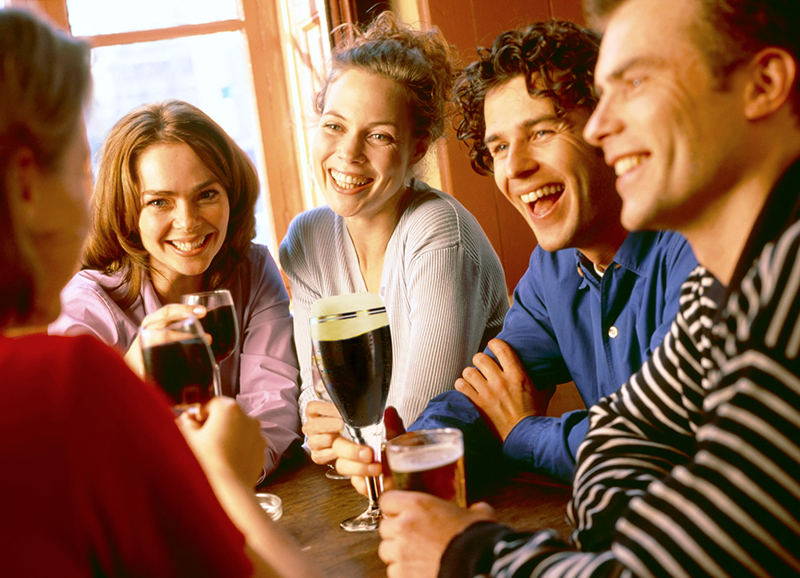 If you spent the winter brewing barleywines, double IPAs, and other high gravity beers, you may be ready for a change of pace. A session beer could be just what you need. As an easy way to get you started, below are 5 session beer recipe kits using extract and partial grains.
If you spent the winter brewing barleywines, double IPAs, and other high gravity beers, you may be ready for a change of pace. A session beer could be just what you need. As an easy way to get you started, below are 5 session beer recipe kits using extract and partial grains.
What are session beers?
Session beers are lower gravity ales and lagers that you can drink repeatedly without getting too buzzed. In other words, you can enjoy a few over a session of drinking. They are highly drinkable (or “sessionable”) beers that are good for a variety of occasions.
But session beers are more than just booze to guzzle down. A session beer recipe should add flavor, too. Beer writer Lew Bryson, founder of the Session Beer Project, gives the session beer definition as following:
- 4.5% alcohol by volume or less
- flavorful enough to be interesting
- balanced enough for multiple pints
- conducive to conversation
- reasonably priced
 Are you ready to brew some session beer recipes? Here are five recipe kits you can craft in your home brewery.
Are you ready to brew some session beer recipes? Here are five recipe kits you can craft in your home brewery.
- Steam Freak High-Flyin’ Derwitzer Wheat – This extract recipe kit creates a golden yellow, German-style wheat beer, also known as a Bavarian hefeweizen. It’s a very easy beer to brew, with bready malt flavor and banana/clove characteristics from the yeast strain. Target alcohol content is 4% ABV.
- Brewers Best English Pale Ale – This five-gallon recipe kit makes an English pale ale in the range of 4.25-4.5% alcohol. Similar to what you might find in an English pub, it features caramel malt flavor, about 30-33 IBUs of hop bitterness, and pleasing, English hop flavor and aroma.
- Brewcraft Premium Series Northlands Nut Brown Ale – With about 4.1% ABV and a smooth, nutty flavor, this nut brown ale is the ultimate session beer recipe kit. A variety of specialty grains, including chocolate malt, caramel malt, and Munich malt, create a rich nutty-chocolatey flavor that goes down easy. English hops round it out with about 25 IBUs and a balanced hop flavor.
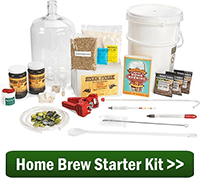
- Steam Freak Bazz Pale Ale (Bass Pale Ale Clone) – Based on one of the beers that made Burton-on-Trent a world-famous brewing city, Bazz Pale Ale features a big dose of caramel malt flavor balanced by European hops. The English yeast strain included in the kit ferments quickly and clean. 33 IBUs, 4% ABV. Of this five, this is my favorite session beer recipe kit.
- Brewers Best Irish Stout – Not all stouts are heavy and high-gravity. Brew a sessionable stout beer with this partial mash kit. Roasted barley and black patent give this beer a dark color and roasty flavor. Shoot for an original gravity in the ballpark of 1.046 to keep the alcohol content around 4.5% ABV.
Do you have a favorite session beer you like to brew? Do you have a session beer recipe kit that is your favorite? Share in the comments below!
—–
David Ackley is a beer writer, brewer, and self-described “craft beer crusader.” He holds a General Certificate in Brewing from the Institute of Brewing and Distilling and is founder and editor of the Local Beer Blog.
From White Stout to Black IPA: Four Homebrew Mash-Up Recipes
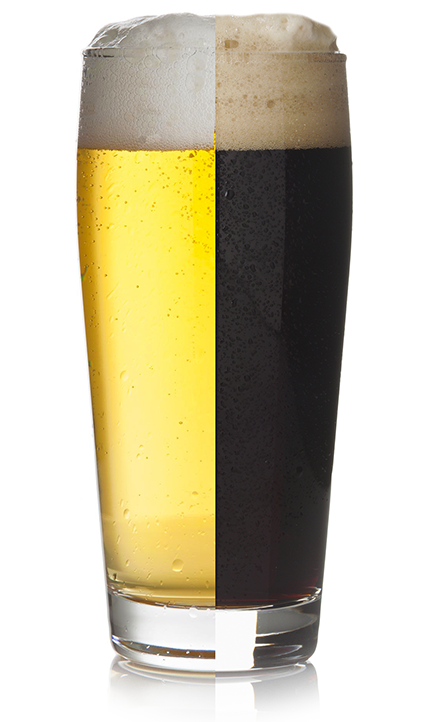 One of the most rewarding aspects of homebrewing is creating your own homebew recipes. This creativity has led to a berth of new beer styles, from black IPAs to white stouts.
One of the most rewarding aspects of homebrewing is creating your own homebew recipes. This creativity has led to a berth of new beer styles, from black IPAs to white stouts.
Sometimes, creating an altogether new beer styles is as easy as switching out a single ingredient in an existing recipe, turning it into a homebrew mash-up recipe of sorts. Here are four recipe ideas to help you brew outside the box.
White Stout Homebrew Recipe
A few craft breweries have released something called a white stout in recent years. There’s still some debate about what defines a white stout, but from what I gather, it’s basically a strong, pale beer. (Back when most beers were dark, strong beers were called stout.) You could try to create the illusion of roasted flavor in the white stout by adding some whole roasted coffee beans to the secondary fermenter. Use this homebrew mash-up recipe as a starting point, optionally adding 8 oz. of whole (not ground) coffee beans to the secondary fermenter.
Belgian IPA Homebrew Recipe
India Pale Ales are an English creation, but I think it’s safe to say that the style has been popularized by American craft brewers and spread throughout the world. It’s not surprising then that we’ve seen a multitude of mash-up variations on the style, including a Belgian spin. A Belgian IPA recipe basically swaps the American or English ale yeast for a Belgian strain, which brings in a range of fruity and spicy characteristics to the beer. Some recipes may also include other throwbacks to traditional Belgian beer styles, like candi sugar, spices, wheat, or oats. For starters, give this Brewers Best Belgian IPA recipe kit a try.
Black Saison Homebrew Recipe
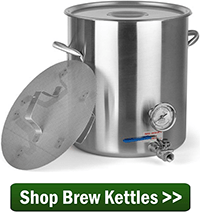 Several craft breweries have jumped on the black saison bandwagon, not the least of which include Stone, Stillwater, and Evil Twin. Their 2012 collaboration, “The Perfect Crime”, wasn’t only dark, it was smoked as well. Their mash-up version contains quite a range of malts in the grain bill: pilsner, red wheat, carafa III, oats, biscuit malt, and smoked wheat. For your first black saison, I’d suggest starting with a Belgian Saison recipe kit and adding up to a pound of carafa III or midnight wheat to get the color you need.
Several craft breweries have jumped on the black saison bandwagon, not the least of which include Stone, Stillwater, and Evil Twin. Their 2012 collaboration, “The Perfect Crime”, wasn’t only dark, it was smoked as well. Their mash-up version contains quite a range of malts in the grain bill: pilsner, red wheat, carafa III, oats, biscuit malt, and smoked wheat. For your first black saison, I’d suggest starting with a Belgian Saison recipe kit and adding up to a pound of carafa III or midnight wheat to get the color you need.
Black IPA Homebrew Recipe
Probably the one homebrew mash-up recipe that has taken off the most, the black IPA features a wonderful combination of roasted malt and spicy hop flavor. I would wager that my Uinta Dubhe Imperial Black IPA clone is one of the best beers I’ve ever brewed. Give that recipe a shot, or try one of the partial mash recipe kits from Steam Freak or Brewcraft.
Do you like to mash together beer recipes into something new? Do you have a favorite homebrew mash-up recipe you’d like to share?
—–
David Ackley is a beer writer, homebrewer, and self-described “craft beer crusader.” He holds a General Certificate in Brewing from the Institute of Brewing and Distilling and is founder of the Local Beer Blog.
Where Do Brewing Hops Come From?
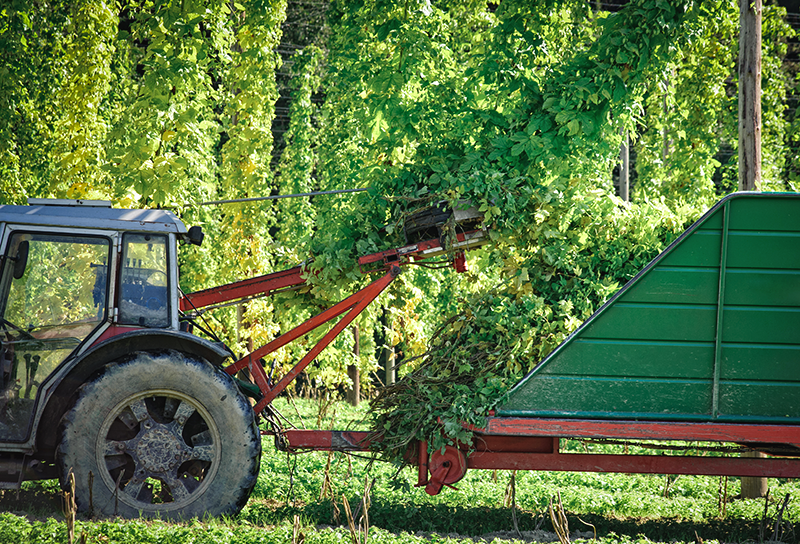 Hops are the flowers from the plant known as humulus lupulus. The hops plant sends up vines (technically “bines”) in the spring, which may climb as high as 20 feet or more. Since only the flowers are used in the brewing process, only the female hops plants have commercial value for brewers.
Hops are the flowers from the plant known as humulus lupulus. The hops plant sends up vines (technically “bines”) in the spring, which may climb as high as 20 feet or more. Since only the flowers are used in the brewing process, only the female hops plants have commercial value for brewers.
Where Do Brewing Hops Grow
Brewing hops grow best between the latitudes of about 35 and 55 degrees. This translates to a strip ranging across roughly the northern two-thirds of the US and most of continental Europe. If you live in this zone, you may be able to grow hops yourself.
Many traditional beer styles are characterized by the variety of hops that grow in a given region. For example, American ales, such as American IPAs, typically exhibit characteristics of hops grown in the Pacific Northwest – notes of citrus and pine are common. The majority of brewing hops grown in the US come from Washington, Oregon, and Idaho. Examples of American hops include Cascade, Centennial, Columbus, and Willamette.
There are a number of hop varieties specific to continental Europe. The noble hop varieties (Hallertau, Tettnang, Saaz, Spalt) all come from Germany and the Czech Republic, and are most often found in traditional European styles like German ales, German lagers, and Czech lagers. Many Belgian beers feature these same hops, as well as Styrian Goldings from the region of the former Yugoslavia.
The UK is another popular hop growing region. Fuggles, East Kent Golding, and Bramling Cross are natural choices if brewing English bitters, porters, barleywines, or stouts.
In recent years, brewing hop production has increased in the southern hemisphere. Hops grown in places you might not expect have started to hit the market: Chile, Argentina, New Zealand. Sierra Nevada pays tribute to some of these distant hop growers with their Southern Hemisphere Harvest IPA.
From the Growing Fields to Your Home Brewery
At the end of the growing season, hops are harvested by machine or by hand, then processed either into pellets or packed in whole cone form. They’re usually pressed into bales for easy shipping and storage.
At some point in this process, the hops may go to a broker who effectively buys the hops from farmers and then distributes them to the various buyers: breweries, homebrew shops, and other hop suppliers.
Throughout this process, hops must be stored cold in order to preserve their flavor and bittering characteristics. This makes sure that by the time the hops hit your brew kettle, they’re just as fresh as they were when they left the field!
Have you ever grown your own hops? What are some of your favorite hop varieties?
—–
David Ackley is a writer, brewer, and craft beer marketing consultant. He holds a General Certificate in Brewing from the Institute of Brewing and Distilling and is founder of the Local Beer Blog.


